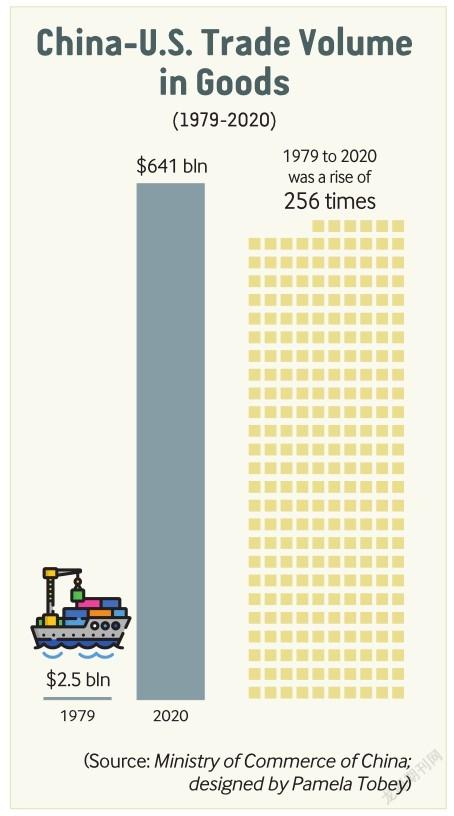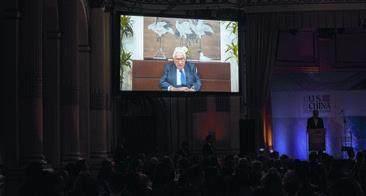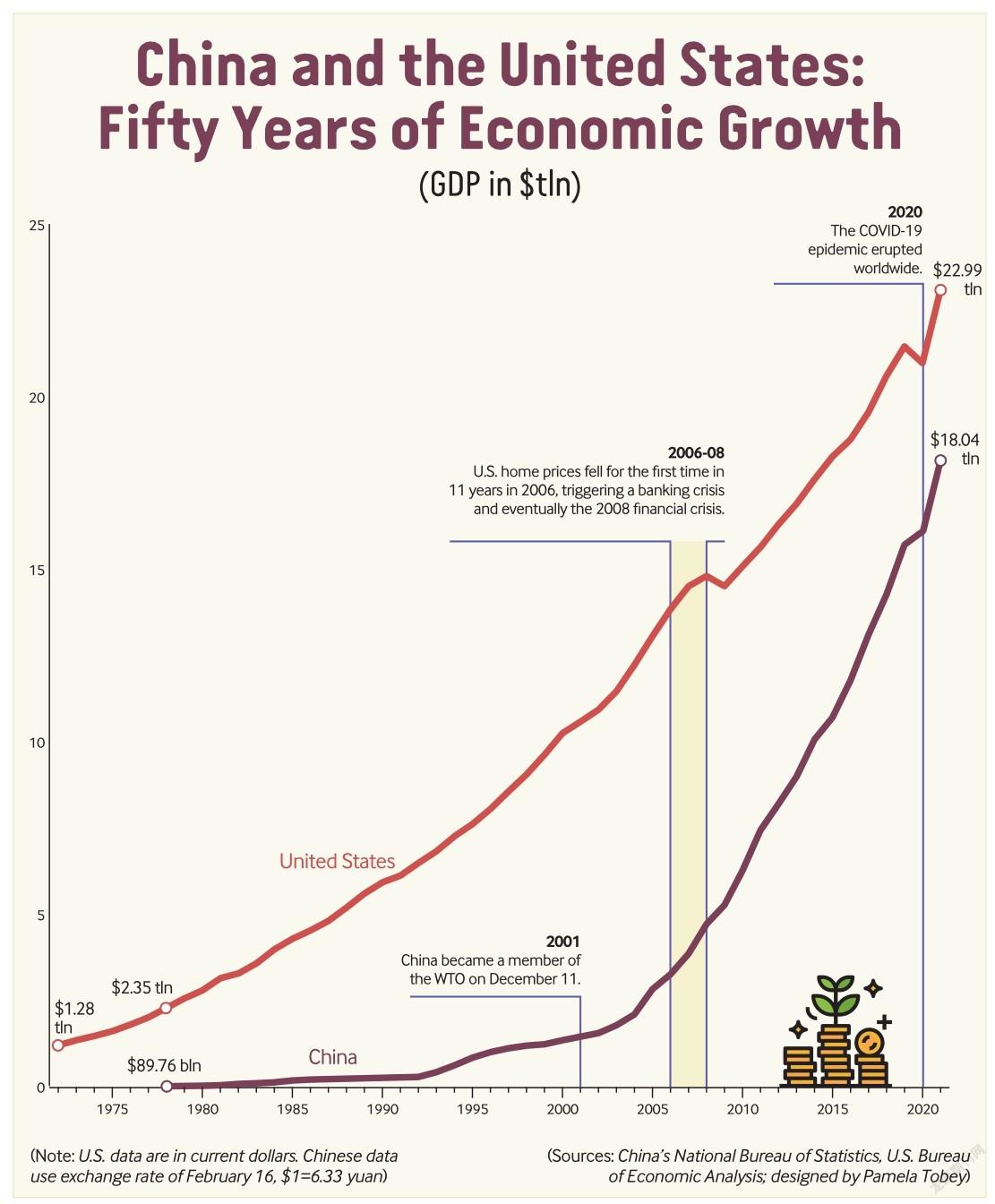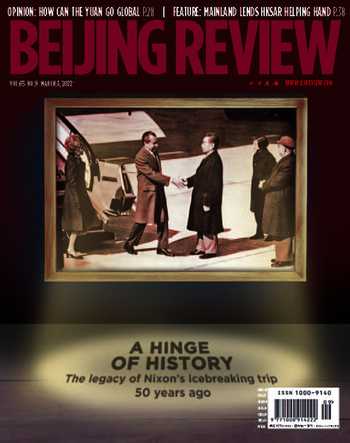THE NEW EQUILIBRIUM
By Wang Dong
On February 21, 1972, U.S. President Richard Nixon embarked on an icebreaking journey to China that proved to be“the week that changed the world.”The handshake between Nixon and Chinese Premier Zhou Enlai when the former stepped off the airplane, captured on lens on site, symbolized the restoration of formal contact between Beijing and Washington, cut off by the Cold War for more than two decades.
Nixon’s historic visit led to the normalization of the Sino-American relationship that fundamentally reconfigured the global balance of power.
However, 50 years on, the China-U.S. relationship has spiraled down to one of its rarest low points in history. Viewing China as a major threat to American hegemony, Washington is determined to launch a fierce “strategic competition” with Beijing. Guided by the so-called Indo-Pacific strategy, the U.S. has mobilized allies and partners in a broad campaign to encircle and exclude China strategically.
The era of engagement ushered in by the Nixon visit now has been declared “over” and many worry we are sliding into a new cold war. However, it is still possible to construct a new equilibrium in China-U.S. relations in the years to come. There are several prerequisites for such a scenario to emerge.
The U.S. must recognize and rectify the epistemological fallacy embedded in the “old engagement consensus”—the bipartisan agreement of engaging China since Nixon that viewed China as “the other” that is to be “changed” and “integrated” into a U.S.-dominated “liberal order.” In that consensus, underpinning the four-decade-plus-long “engagement strategy” toward China, Washington implicitly expected that China would gradually become like the U.S., economically and even, over time, politically.

This fallacy is like the one embodied in an ancient Chinese tale called kezhou qiujian, literally “to carve a mark on the boat to find one’s lost sword.” American expectations about“liberalizing” China correspond to the mark the man engraved on the gunwale. And like the man who failed to retrieve the lost sword, the American expectations of “changing” China, unsurprisingly, would fail.
Unfortunately, instead of critically reflecting on such an epistemological fallacy, U.S. elites have now shifted from one extreme to another, viewing China as an authoritarian and revisionist power bent on challenging and replacing American hegemony. Hence, Washington vows to “compete” with China with the goal of defending U.S. primacy.
As the previous consensus can no longer provide a sufficient intellectual framework for conceptualizing the relationship between both nations, a new intellectual framework—a new engagement consensus based on equality and mutual respect—is necessary. A new accord would require Washington to abandon a zero-sum mentality and instead conceive of power as a positivesum game. It would allow for a new global order in which China and the U.S. would coexist.
On a second note, the U.S. and its Western allies must rectify the sense of irrationalism or worse, racism, in their approach to “compete” with China. As tensions in Sino-American relations rise, the China narrative in the U.S. has become anything but rational. Indeed, it has turned out to be a mixture of emotion, misperception, fear, anxiety, prejudice, selfrighteousness, paranoia and even racism. The country has engaged in a process of “othering,” which involves dehumanizing China as an authoritarian, repressive and aggressive power that stands in opposition to the “liberal, democratic world”represented by the U.S. and its allies.
For instance, EU High Representative for Foreign Affairs and Security Policy Josep Borrell Fontelles told a forum in November 2021, “We Western people, the U.S. and EU, we have been ruling the world... We are the masters of how technology was working... If we are no longer selling the standard, we will not rule the 21st century.” This kind of public display of Western-centric superiority and borderline racism could not be more unsettling. If Washington and associates were to develop a progressive China policy in the months and years to come, such inherent discrimination must be rectified.

Third, the U.S. must stop interfering with China’s internal affairs. The issues concerning Taiwan, Xinjiang Uygur Autonomous Region and Hong Kong are purely of internal concern, and the U.S. must cease and desist from slandering China on misrepresentation and prejudice. The Joe Biden administration should abide by the one-China principle not only through words, but through actions. The one-China principle and the three Sino-American joint communiqués, namely the 1972 communiqué(the Shanghai Communiqué), the 1979 communiqué on the establishment of diplomatic relations and the 1982 communiqué, are the political foundations of bilateral relationship which must be sincerely upheld. Instead of pursuing a damaging, complete decoupling, the U.S. and China should be thinking in terms of “recoupling”—relinking their economies on a new basis of reciprocity and mutual respect. The former should have an accurate and rational assessment of the disagreements and frictions in economic and trade areas between both countries. It is counterproductive and detrimental to politicize economic issues or hype up unfounded security risks.
Unfortunately, caving to domestic political pressures and bearing in mind mid-term elections, the Biden administration seems to be taking regressive rather than progressive steps in its trade policy toward China. Rather than succumbing to domestic political calculations, it should have the courage to do what is right and help steer Sino-American relations back on track.

In the geopolitical realm, then, the U.S. and China should both exercise prudence and shun any vicious geopolitical competition. Since taking office, President Biden has been arduously mobilizing allies to join hands in counterbalancing China. He inherited Donald Trump’s Indo-Pacific strategy, focusing on marshaling a network of regional allies and partners to checkmate China. After elevating the so-called Quad(an informal grouping composed of the U.S., Japan, India and Australia) to a leader-level summit, the U.S. announced an enhanced trilateral security alliance with the UK and Australia, namely AUKUS. It also pushed Group of Seven members to launch the Build Back Better World Partnership, a global infrastructure program to counter the Chinaproposed Belt and Road Initiative.
The future regional order has to be inclusive and integrated, rather than one of exclusion and bloc-rivalry. Any vision of an arrangement that is “U.S./West-centric” and excludes China will harm the peace and stability in the region.
Next, instead of using international organizations as a tool to restrain China’s development or dent its influence, the U.S. should genuinely embrace multilateralism, maintain the stability of international order based on the UN Charter, and proactively carry out constructive dialogue and profound reform with the international community by way of joint consultation. It should not treat world bodies merely as “problem-solvers at the service of the U.S.” or as a battleground for great-power struggles.
People-to-people exchanges between China and the U.S. should be given full rein. In what is dubbed by Chinese netizens as Ping Pong Diplomacy 2.0, Chinese and American players teamed up to compete together for the mixed doubles event at the 2021 World Table Tennis Championships.
Take the Institute for Global Cooperation and Understanding (iGCU) at Peking University (PKU) , for example. It has been committed to boost China-U.S. people-to-people exchanges, especially fostering communication between young people. In collaboration with the George H.W. Bush Foundation on U.S.-China Relations, we conducted three rounds of Strategic and Policy Dialogue, focusing on economic and trade cooperation, security and Afghanistan, respectively. Since 2016, the iGCU, in partnership with the Global Times and the Carter Center, has successfully co-hosted the China-U.S. Young Scholars Forum (CUYSF) for six consecutive years. On April 10 last year, for the 50th anniversary of Ping Pong Diplomacy, we organized a special event marking the fifth anniversary of the CUYSF, assembling over 50 of its alumni. We also facilitated several student exchanges between Georgetown University and PKU, including one on climate change last year.
What impresses me most is that when young people come together, there is no baggage of ideological prejudices, and they can engage in genuine, candid, mutually respectful, warm and indeed inspiring interactions. President Xi Jinping has said many times that “the hope of China-U.S. relations rests on the shoulders of young people.”This could not ring truer.

Nowadays, some U.S. politicians and strategic analysts like to refer to China as a “strategic competitor.”Yet China is a reluctant rival. Beijing has no interest in entering the game of competing for global primacy with the U.S. However, pushed by Washington’s heavy-handed competition strategies in defense of American hegemony, Beijing sees no choice but to resolutely defend its own right to sovereignty, security and development. Stabilizing SinoAmerican relations and preventing them from spiraling into a new cold war remain the key goals of China’s policy toward the U.S.
Fifty years ago, when Nixon visited China, he had second thoughts worrying about the Chinese “kowtow” etiquette—which later was confirmed as only hearsay. Today, history and the new era both require American policymakers to support reason and objectivity, and abandon prejudice and paranoia.
In the spirit of equality and mutual benefit, the U.S. should accurately, comprehensively, and fairly appraise China’s development goals and strategic intentions, and work with China to achieve a new equilibrium in the relationship. As President Xi stated during his video summit with President Biden, “China and the U.S. are two giant ships sailing in the ocean. It is important for both sides to keep a steady hand on the tiller, so that the two vessels will break the waves and forge ahead together, without losing direction or speed, still less colliding with each other.” BR

3587500338201

